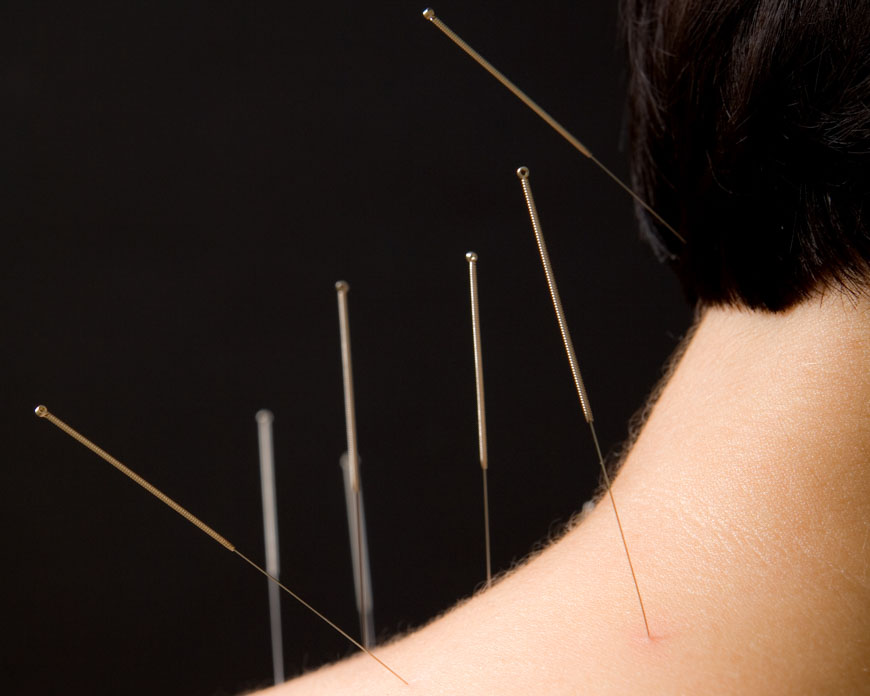
Acupuncture is effective for the alleviation of neck pain due to cervical spondylosis, a disorder caused by intervertebral disc degeneration. Researchers determined that electroacupuncture provides optimal therapeutic results when compared with manual acupuncture. Electroacupuncture produced a 96.67% total effective rate and manual acupuncture produced an 86.7% total effective rate.
After completion of all acupuncture treatments, 18 patients in the electroacupuncture group were completely asymptomatic and their neck and limb functions restored to normal. An additional 11 patients had a significant reduction of symptoms and improvements of neck and limb functions. One patient did not have any improvements, yielding the total effective rate of 96.67%.
The researchers focused on the use of Huatuojiaji points and compared identical acupuncture treatments, with the exception of one parameter. Electroacupuncture was added in one group and only manual acupuncture was applied in the other. Each group was subdivided into three diagnostic parameters: cervical spondylotic radiculopathy, cervical spondylotic myelopathy, vertebral artery type cervical spondylosis. Specific acupuncture point prescriptions were formulated for each subgroup.
Subgroup Differentiation
Cervical spondylotic radiculopathy, occurs when nerves are impinged and there is subsequent pain, numbness, or weakness. Cervical spondylotic myelopathy involves compression of the spinal cord; there is often numbness, tingling extending through the arms, weakness, balance issues, vertigo, loss of motor skills, pain, and stiffness. Vertebral artery type cervical spondylosis indicates that the degenerative process has affected the vertebral artery and there is often dizziness or even blackouts when turning or bending the neck.
Research Design
In a clinical trial from May 2017 to May 2019 (Beijing, China), 60 cases with cervical spondylosis were randomly divided into two groups of 30 patients. For the manual acupuncture group, the patient sample was comprised of 18 males and 12 females, with an average age of 53.7 ±5.4 years. The electroacupuncture group was comprised of 17 males and 13 females, with an average age of 56.5 ±5.1. There was no significant statistical distinction between the two groups prior to beginning the investigation. Next, all 60 patients were classified into 3 categories based on their symptoms:cervical spondylotic radiculopathy, cervical spondylotic myelopathy, vertebral artery type cervical spondylosis.
All patients received acupuncture at Huatuojiaji points from C3–7, bilaterally. After this procedure, patients with cervical spondylotic radiculopathy received the following acupoints:
- GB20 (Fengchi)
- GV14 (Dazhui)
- LI4 (Hegu)
- LI11 (Quchi)
- GB21 (Jianjing)
Cervical spondylotic myelopathy patients received the following acupoints:
- LV8 (Ququan)
- PC3 (Quze)
- MHN3 (Yintang)
- GB20 (Fengchi)
Vertebral artery type cervical spondylosis patients received the following:
- PC3 (Quze)
- BL40 (Weizhong)
- BL23 (Shenshu)
- GV3(Yanyangguan)
Acupuncture Techniques
Needles with a length of 1.5 cun were sterilized and then inserted to the aforementioned points with a 30 degree angle, using a Ping Bu Ping Xie (mild tonifying and attenuating) manipulation technique. Optimal depth was 0.5–1 cun, ensuring that patients experienced a sore or numbing deqi sensation. Needles were retained for 20 minutes. Treatment was given on alternate days for a duration of 60 days.
Both groups received the same treatments; however, the electroacupuncture group also received electroacupuncture stimulation. The acupuncture needles were connected to an electroacupuncture device with a sparse-dense wave, with the intensity level set to patient tolerance levels. The needles were retained for 20 minutes once electroacupuncture was initiated.
Chinese Medicine Principles
The researches cited Chinese medicine principles for the treatment protocol choices: acupuncture regulates qi and blood, relaxes meridians, and activates collaterals. Treatment at EX-B2 (Huotuoiaji) points, in particular, breaks the stasis along the Tai Yang meridian, dispels cold and wind, regulates the internal microcirculation of blood. Consequently, blood supply to a patient’s neck is restored, greatly relieving clinical symptoms. [1]
Observation metrics relied on clinical efficacy. Outcome measures consisted of three categories: recovered (clinical symptoms eliminated, neck and limbs function normally), effective (clinical symptoms alleviated, neck and limb function improves), ineffective (symptoms persisted or aggravated). Of the 30 cases in the electroacupuncture group, 18 cases recovered, 11 cases were effective, and one case was ineffective, making the total effective rate 96.67%. The manual acupuncture group achieved an 86.70% total effective rate.
Cervical Spondylotic Myelopathy Investigation
An independent investigation produced similar findings on acupuncture for the treatment of cervical spondylotic myelopathy. The study compared the efficacy of electroacupuncture and manual acupuncture. From April 2016 to May 2018, 60 patients were randomly divided into two groups. Patient age ranged from 40–70 years. The electroacupuncture group consisted of 17 males and 13 females, with a mean age of 57.95 ±1.37. The manual acupuncture group consisted of 19 males and 11 females, with a mean age of 55.83 ±1.12 years.
Both groups were prescribed conventional medications, including intravenous mannitol injections, intravenous dexamethasone phosphate sodium injections (a corticosteroid), and oral mecobalamine tablets (vitamin B12). The medications were administered over a four week period. The two groups received treatment on the following acupoints bilaterally:
- EX-B2 (Huatuojiaji, C4–7)
- GB20 (Fengchi)
- LI11 (Quchi)
- TB5 (Waiguan)
- ST36 (Zusanli)
- SP6 (Sanyinjiao)
The electroacupuncture group received electroacupuncture at EX-B2 (Huatuojiaji, C4–7) acupoints. They were connected to an electroacupuncture device with an intermittent wave. Frequency was set to 80 Hz/min. Intensity was based on individual patient comfort levels. Twenty minutes of electroacupuncture or manual acupuncture was administered for the groups each day for a period of 4 weeks.
Outcome measures were the same basic clinical parameters as the prior investigation. The electroacupuncture group demonstrated better patient outcomes, with an effective rate of 96.67%, compared to 93.33% in the manual acupuncture group. Notably, patients in the electroacupuncture group showed more significant improvements in Visual Analogue Scale (VAS) and quality of life scores. [2]
References:
[1] Lu Yuling, Clinical effect of electroacupuncture at Jiaji point in the treatment of cervical spondylosis, CHINESE COMMUNITY DOCTORS, 2020.02.054.
[2] Jiang Guo, Observation on treating cervical spondylotic myelopathy by electroacupuncture at Jingzhuibing points, Clinical Journal of Chinese Medicine, 2019 (11) No.34.


